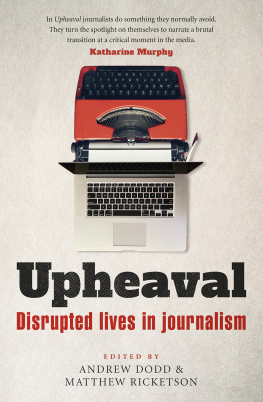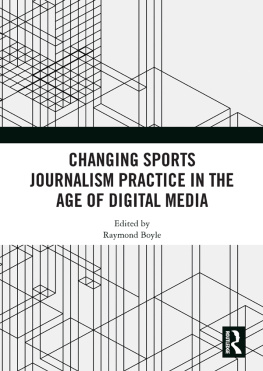Table of Contents
Page List
Guide

In Upheaval journalists do something they normally avoid. They turn the spotlight on themselves and their industry. They narrate a brutal transition at a critical moment in the media. This oral history documents the culture of Australian journalism before the internet extemporising, sexist, booze-fuelled and brash and reveals the private pain of the digital dislocation for many journalism lifers who had to reshape their professional identities. Upheaval puts readers in the newsroom as the rivers of gold dried up.
Katharine Murphy, political editor, Guardian Australia
Essential reading for those who care about journalism and its struggle to survive. This book captures the essence of what it is to be a reporter amid tectonic shifts in the media and in the world that we strive to make sense of for our audiences. Anyone who follows the news and politics will be absorbed by Upheaval.
Nick McKenzie, investigative journalist, The Age and The Sydney Morning Herald
Few occupations have gone through such a rapid transformation as journalism. Important and original, Upheaval illuminates aspects of contemporary journalism that few, if any, other books have achieved.
Rodney Tiffen, emeritus professor, University of Sydney
To journalists who seek light, not heat.
A UNSW Press book
Published by
NewSouth Publishing
University of New South Wales Press Ltd
University of New South Wales
Sydney NSW 2052
AUSTRALIA
newsouthpublishing.com
Andrew Dodd and Matthew Ricketson 2021
First published 2021
This book is copyright. While copyright of the work as a whole is vested in the editors, copyright of individual chapters is retained by the chapter authors. Apart from any fair dealing for the purpose of private study, research, criticism or review, as permitted under the Copyright Act, no part of this book may be reproduced by any process without written permission. Inquiries should be addressed to the publisher.
ISBN9781742237275 (paperback)
9781742245287 (ebook)
9781742249841 (ePDF)
 | A catalogue record for this
book is available from the
National Library of Australia |
Design Josephine Pajor-Markus
Cover design Luke Causby, Blue Cork
All reasonable efforts were taken to obtain permission to use copyright material reproduced in this book, but in some cases copyright could not be traced. The editors welcome information in this regard.

Contents
Andrew Dodd and Matthew Ricketson
Lawrie Zion
Andrew Dodd
Lawrie Zion
Andrew Dodd, Matthew Ricketson and Penny ODonnell
Penny ODonnell and Matthew Ricketson
Penny ODonnell, Merryn Sherwood and Brad Buller
Andrew Dodd
Matthew Ricketson
Merryn Sherwood and Matthew Ricketson
Brad Buller
Matthew Ricketson
Merryn Sherwood and Andrew Dodd
Matthew Ricketson and Timothy Marjoribanks
Penny ODonnell, Brad Buller and Matthew Ricketson
Andrew Dodd and Timothy Marjoribanks
Andrew Dodd
Penny ODonnell and Lawrie Zion
Penny ODonnell and Timothy Marjoribanks
Penny ODonnell
Andrew Dodd and Matthew Ricketson
CHAPTER 1
The precede
Andrew Dodd
Matthew Ricketson
Once The Age required an entire building. Now everything fits on one floor. To reach it, you go to the Melbourne headquarters of the Nine Entertainment Company. Its an office tower, with glass panels and polished surfaces and only a few traces of Nines past. The workers rush past the old tripod-mounted TV camera on display and the monitors screening network shows on the wall. They wave staff cards above the turnstiles before heading to different sets of lifts where they diverge one way for insurance offices and telecommunication companies, or another way for the television newsroom.
The lift opens on a dimly lit corridor on the seventh floor, the new home of the Fairfax Media newspapers that Nine acquired after the last of the longstanding media ownership rules were dismantled in 2017. Turn right for The Age or left for The Australian Financial Review. Either way, youll end up in the same horseshoe-shaped newsroom. Look around the floor and you can see the newsroom, all its sections, the library, editorial conference rooms, graphic department, podcast and video studios and the staff kitchens. You can also see The Fin Reviews own cluster of desks. On the walls are references to the 180-year heritage of the Fairfax empire, including an excerpt from The Fin Reviews first editorial and a quote from The Ages revered editor Graham Perkin reminding staff the newspaper does certain things differently because it has a responsibility to our readers and to society in general.
Less than two decades ago, Fairfax, along with the rest of the Australian media, had boundless optimism about the future. In 2003 new presses were built at a $220 million printing plant near Tullamarine Airport. The facility featured a sculptured desert rock garden and a tall statue, which was described mockingly by author Rachel Buchanan as a luminous half-furled copy of The Age that rose 32-metres high made of 542 glass panels attached to a steel frame, each one shaped by computer modelling. Journalist David Marr would often pass the facility on the freeway from the airport, on his regular visits to Melbourne. He described it as an extravagant triumphalist building. But on one visit he noticed the presses had gone, and the site was desperately for sale, or for lease or for anything. There were fewer pages to print so the work could be done at Fairfaxs press in Ballarat in regional Victoria.
In 2007 the Howard Coalition government succeeded in watering down Paul Keatings cross-media ownership rules, which had prevented any company owning more than one of the major mediums of radio, TV or print in the same market. The new rules allowed companies to own two of the three mediums, prompting a complex deal that resulted in the owners of The Age also owning Southern Crosss influential metropolitan radio station 3AW.
Within two years, the former rivals occupied the same building, the purpose-built, stylishly modern Media House just 300 metres away from Nines current location and two city blocks from The Ages longstanding home on Lonsdale Street. Rising up on the corner of Collins and Spencer streets, Media House reflected how confidence persisted before journalisms business model collapsed and disruption swept away thousands of jobs. Soon the effects were visible inside the building, with The Age reduced to occupying just the second floor. The library and The Fin Review moved on to the same level too, along with sales and marketing and management. And then came the Turnbull governments changes in 2017, allowing companies to own all three mediums in the same market. The owners of Nine were free to also own The Age and 3AW and they soon swooped, prompting the move one city block across to Nines headquarters. 3AW remained at Media House, due to its technical studio requirements, but nothing is stopping the three former rivals cohabiting a clear sign of the deregulation of the industry and of Australias diminishing media diversity.









